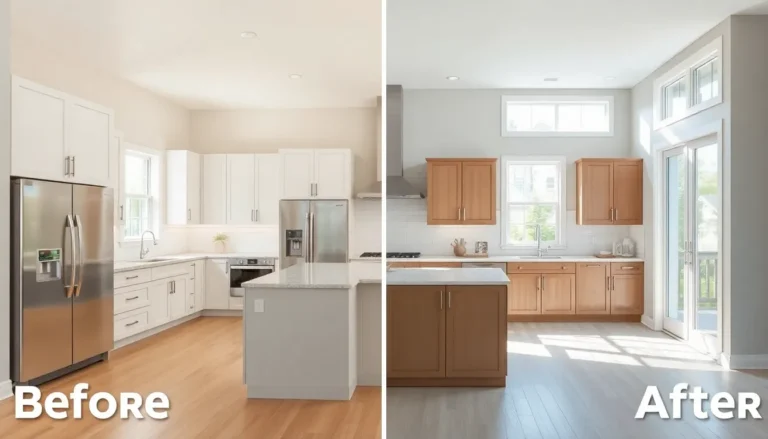Table of Contents
ToggleWhen it comes to home improvement, the terms “remodeled” and “renovated” often get tossed around like confetti at a parade. But hold on—these two words aren’t just interchangeable buzzwords. They each carry distinct meanings that can make or break your next home project.
Understanding Remodeled vs Renovated
Distinguishing between remodeled and renovated is vital in home improvement. These terms hold specific meanings that can influence project outcomes.
Definitions of Remodeling
Remodeling refers to altering a space’s structure or function. This process often includes expanding rooms, changing layouts, or adding new features. For example, converting a basement into a living space counts as remodeling. Homeowners might seek a new look or enhance functionality through such projects. Remodeling usually requires significant planning and may involve permits, depending on the scope.
Definitions of Renovation
Renovation emphasizes restoring or updating an existing space. This can involve tasks like painting walls, replacing flooring, or updating fixtures. For instance, refreshing an outdated kitchen with new cabinets and countertops is a renovation. Renovation tends to focus on aesthetics and improving the overall condition of a space without major structural changes. Understanding this difference helps homeowners set clear goals for their projects.
Key Differences Between Remodeling and Renovation

Understanding the differences between remodeling and renovation is essential for homeowners aiming to enhance their properties. These terms imply unique approaches to home improvement, impacting goals and outcomes.
Impact on Property Value
Remodeling typically raises property value significantly. Structural changes create added functionality and aesthetics, attracting potential buyers. Renovation also enhances value, though impacts are often more modest, focusing mainly on visual appeal. Upgrades like new fixtures and fresh paint can appeal to buyers, but they won’t increase space like remodeling. When planning projects, consider the potential return on investment for each option to make informed decisions.
Scope of Work Involved
Remodeling entails extensive work that changes a space’s structure and layout. Projects often require architects, designers, and specific permits, reflecting higher complexity. In contrast, renovation involves less invasive tasks aimed at updating an existing space. Aspects like painting, flooring, and fixture replacements generally characterize renovation. These projects can often be completed quickly without comprehensive planning. Assess needs carefully to determine which approach suits specific home improvement goals.
Reasons to Choose Remodeling or Renovation
Considering individual goals helps homeowners decide between remodeling and renovation. Homeowners prioritize functionality and aesthetics when selecting their path for home improvement.
Personal Preferences
Styles and tastes influence decisions significantly. Some homeowners prefer the extensive changes remodeling offers, as it allows for a complete reimagining of space. Others value the quick updates renovations provide, favoring ease and simplicity. Personal comfort often drives the choice, as individuals may want their home to reflect their unique personality. Space utilization and layout transform their living experience, making remodeling appealing for those who prioritize practical enhancements. Visual upgrades from renovations cater to those seeking fresh looks without major alterations. The balance between personal comfort and desired changes plays a crucial role in decision-making.
Budget Considerations
Costs dictate many home improvement choices. Remodeling usually involves higher expenses due to structural changes, permits, and professional labor. Homeowners often need to consider their finances carefully before undertaking such projects. Renovation offers a more budget-friendly alternative, enabling updates and repairs without significant investments. Homeowners can complete renovations with smaller budgets by focusing on visual and aesthetic improvements. Long-term value also affects budget discussions, as remodeling often raises property value significantly more than renovations do. Evaluating potential return on investment helps homeowners determine which option aligns with their financial goals.
Common Misconceptions
Home improvement terms often create confusion among homeowners. Many people mistakenly use “remodeled” and “renovated” interchangeably. Recognizing the distinct meanings behind these terms plays an essential role in project planning and execution.
One common misconception is that all updates qualify as remodeling. Structural changes, such as altering layouts or expanding rooms, define remodeling. A simple fresh coat of paint or new fixtures aligns with the renovation category, which centers on aesthetics rather than functionality.
Another misunderstanding involves costs associated with remodeling and renovation. Homeowners frequently assume renovation projects are cheaper. While renovations typically involve less labor and fewer materials, remodeling can yield significant return on investment despite higher initial costs. Evaluating potential value increases helps clarify which option fits better within financial plans.
Moreover, some believe that remodeling requires more time than renovation. In reality, extensive structural work might demand more planning but can result in faster overall project completion. Small renovations may appear quick but often involve tedious tasks like dealing with unexpected repairs.
Lastly, many think that renovations don’t add substantial value to a home. Although they primarily enhance visual appeal, renovations still contribute to property value. Understanding the impact of both approaches enables homeowners to assess potential returns effectively. Overall, recognizing these misconceptions helps clarify project objectives, aligning strategies with individual home improvement goals.
Understanding the distinction between remodeling and renovation is essential for any homeowner embarking on a home improvement journey. Each approach offers unique benefits and challenges that cater to different goals and budgets. By clarifying whether to remodel or renovate, homeowners can make informed decisions that align with their vision for their space.
Ultimately, knowing the differences not only aids in planning but also enhances the potential return on investment. Whether opting for structural changes or aesthetic updates, homeowners can confidently pursue projects that elevate their living spaces and meet their individual needs.





